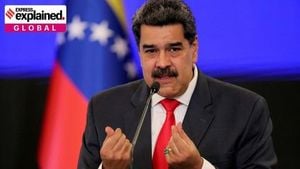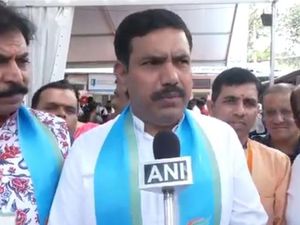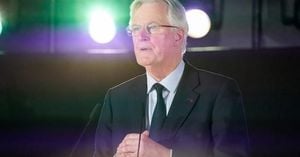On a brisk September night in 2025, late-night television found itself at the heart of a political firestorm that few could have predicted. The catalyst? A public feud between US President Donald Trump and comedian Jimmy Kimmel, whose show on Disney’s ABC network became the unlikely epicenter of a national debate over free speech, government power, and the future of American broadcasting.
The chain of events began on Wednesday, September 17, when Disney suspended Jimmy Kimmel Live! following a series of critical remarks by Kimmel about prominent political figures. The move, prompted by mounting external pressure—including pointed comments from FCC Chair Brendan Carr—sent shockwaves through both the media industry and the American public. Carr’s warning to broadcasters was clear: continuing to air Kimmel’s show could put their licenses at risk, a not-so-veiled threat that underscored the stakes for ABC and its parent company, Disney.
As reported by the Financial Times, President Trump escalated the situation with a fiery social media post just hours before Kimmel’s scheduled return to the airwaves on Tuesday, September 23. “Let Jimmy Kimmel rot in his bad Ratings,” Trump wrote, setting the tone for a week of confrontation and controversy. But if Trump’s intent was to diminish Kimmel’s impact, the result was quite the opposite. On the night of his return, Jimmy Kimmel Live! drew 6.3 million viewers—more than three times its usual audience—thanks in large part to the very protests and political drama that had surrounded his brief suspension.
According to The Conversation, the public’s reaction to the Trump Administration’s efforts to pressure broadcasters was overwhelmingly negative. A YouGov poll conducted that week found that 68% of Americans considered it unacceptable for the government to try to remove shows it disagreed with, compared to just 12% who found such interference acceptable. The poll’s findings reflected a broader discomfort with the Administration’s approach to media criticism, suggesting that the attempt to sideline Kimmel may have backfired both politically and culturally.
Disney, meanwhile, wasn’t caught off guard. Ahead of Kimmel’s reinstatement, the company’s legal team consulted with a cadre of experts to evaluate the risks and prepare for any potential backlash from the Trump Administration. As detailed by internal sources and legal analysts interviewed by The Conversation, Disney executives received assurances that their legal standing was strong. The company’s confidence rested on constitutional protections that make it extremely difficult for a broadcaster to lose its license solely because of unfavorable political content. Preston Padden, a former ABC Television president, remarked that the odds of such a license being revoked for airing politically sensitive material were “highly unlikely under existing laws.”
Despite this legal confidence, Disney recognized the complexity—and unpredictability—of the situation. The Administration’s history of contentious interactions with media companies, coupled with FCC Chair Carr’s public admonishments, created a climate of uncertainty. Major broadcasting affiliates like Nexstar responded to Carr’s threats by pulling Kimmel’s show from their station lineups, and Disney’s decision to suspend Kimmel, at least temporarily, was seen as a pragmatic response to the mounting risks. Not all Disney executives agreed with the suspension, but the political pressure proved difficult to ignore.
In the days that followed, public protests and a surge of consumer backlash forced Disney’s hand. The company reinstated Kimmel by the following week, although some major affiliates, including Sinclair and Nexstar, initially resisted bringing the show back. The episode highlighted the sway that political dynamics can hold over media operations, as well as the power of public opinion to push back against perceived overreach.
For Disney, the ordeal was more than a public relations headache; it was a legal and strategic challenge that could have lasting implications. The company’s legal team braced for the possibility of court battles with the Trump Administration, particularly over threats to ABC’s broadcasting license. While most legal analysts agreed that Disney’s case was strong, some cautioned that the Administration’s willingness to pursue aggressive tactics should not be underestimated. The unpredictability of legal battles against a politically active government, they warned, left little room for complacency.
The stakes were high not just for Disney, but for the entire broadcasting industry. The Administration’s threats and the FCC’s warnings signaled a new era of tension between government and media, one in which the boundaries of free expression and political influence would be tested in courtrooms and boardrooms alike. According to experts cited by The Conversation, one likely outcome is increased self-censorship among broadcasters, as companies weigh the risks of airing content that could provoke political backlash. This chilling effect could alter programming decisions not only at ABC, but across the media landscape, with long-term consequences for free expression and public discourse.
Amid these legal and political battles, Trump’s own approval ratings were taking a hit. According to Nate Silver’s aggregation of US national polls, Trump’s net approval rating slid two points in the last week of September to -9.4, with 53.1% of Americans disapproving of his performance and just 43.7% approving. This marked only a slight improvement from his worst net approval of the term, -10.3, recorded in July. Silver’s historical data showed that Trump’s ratings at this stage were worse than any other president since Harry Truman, with the exception of his own earlier numbers. The slide in approval was attributed in part to the administration’s controversial attempts to silence Kimmel, as well as ongoing concerns about inflation—on which Trump’s net approval had dropped six points to -30.0 since the end of August.
Yet, the political drama played out against a backdrop of a resilient US stock market. The S&P 500 index peaked at nearly 6,700 points on Monday, September 22—a 2.8% rise in the past month—suggesting that, for now at least, economic fundamentals remained strong despite political turbulence.
Elsewhere in politics, Democrats held Arizona’s seventh House district in a special election with a substantial swing in their favor, signaling potential momentum ahead of the November state and local elections. In the UK, the far-right Reform party led Labour by about ten points in national polls, underscoring the volatility of global politics in late 2025.
Back in the US, the Kimmel controversy left Disney facing an uncertain future. The company’s legal team was preparing for a drawn-out confrontation with the Trump Administration, one that could reshape the regulatory landscape for years to come. As legal analysts and industry insiders watched closely, the episode served as a stark reminder of the delicate balance between government oversight and media independence—a balance that, in 2025, seemed more precarious than ever.
For now, Jimmy Kimmel is back on the air, his ratings riding high on a wave of public support and political drama. But behind the scenes, Disney and the broader media industry are bracing for whatever comes next in this ongoing battle over free speech and government power.





